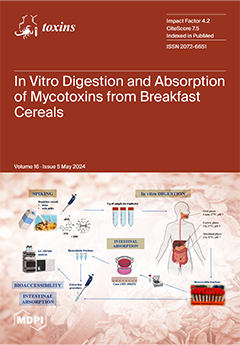Scorpion envenomation poses a global public health issue, with an estimated 1,500,000 cases worldwide annually resulting in 2600 deaths. North Africa, particularly Morocco, experiences severe envenomations, mainly attributed to
Androctonus mauretanicus and
Buthus occitanus in Morocco, and
Buthus occitanus and
Androctonus australis hector
[...] Read more.
Scorpion envenomation poses a global public health issue, with an estimated 1,500,000 cases worldwide annually resulting in 2600 deaths. North Africa, particularly Morocco, experiences severe envenomations, mainly attributed to
Androctonus mauretanicus and
Buthus occitanus in Morocco, and
Buthus occitanus and
Androctonus australis hector in Algeria and Tunisia, with case numbers often underestimated. Current treatment relies mainly on symptomatic approaches, except in Morocco, where management is limited to symptomatic treatment due to controversies regarding specific treatment. In Morocco, between 30,000 and 50,000 scorpion envenomation cases are reported annually, leading to hundreds of deaths, mainly among children. Controversies among clinicians persist regarding the appropriate course of action, often limiting treatments to symptomatic measures. The absence of a specific antivenom for the venoms of the most lethal scorpions further exacerbates the situation. This study aims to address this gap by developing a monovalent antivenom against the endemic and most dangerous scorpion,
Androctonus mauretanicus. The antivenom was produced by immunizing albino rabbits with a mixture of
Androctonus mauretanicus venom collected from high-risk areas in Morocco. Immunizations were performed by subcutaneous injections at multiple sites near the lymphatic system, following an immunization schedule. Production control of neutralizing antibody titers was conducted through immunodiffusion. Once a sufficient antibody titer was achieved, blood collection was performed, and the recovered plasma underwent affinity chromatography. The efficacy of purified IgG was evaluated by determining the ED
50 in mice, complemented by histological and immunohistochemical studies on its ability to neutralize venom-induced tissue alterations and the neutralization of toxins bound to receptors in the studied organs. The monovalent antivenom demonstrated specificity against
Androctonus mauretanicus venom and effective cross-protection against the venom of the scorpions
Buthus occitanus and
Androctonus australis hector, highly implicated in lethal envenomations in the Maghreb. This study shows that the developed monovalent antivenom exhibits notable efficacy against local scorpions and a surprising ability to neutralize the most lethal envenomations in North Africa. These results pave the way for a new, more specific, and promising therapeutic approach to countering severe scorpion envenomations, especially in Morocco, where specific treatment is lacking.
Full article






